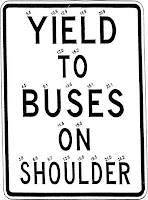Major cities across the nation experience severe traffic congestion. New ideas are needed to safely move more people using existing resources. Many severely congested roads have 10- to 12-foot wide shoulders that could be used by transit buses to bypass the congestion with little or no infrastructure improvements. The operation of buses on shoulders (BOS) is necessary because of the limited right-of-way and the high costs associated with creating new infrastructure. BOS concepts could also be applied to planning new infrastructure.
Buses traveling on shoulders can deliver a consistently reliable schedule to passengers, regardless of the traffic conditions along the route. Transit agencies could use shoulders for service, such as bus rapid transit, express, or fixed routes, along certain congested roads. Experience has provided encouraging results. On congested roads, BOS can support cost-effective multimodal transportation choices, improve bus schedule reliability, potentially reduce operational costs, and attract more automobile drivers to buses.
Questions asked by agencies regarding the potential introduction of BOS systems include
Buses traveling on shoulders can deliver a consistently reliable schedule to passengers, regardless of the traffic conditions along the route. Transit agencies could use shoulders for service, such as bus rapid transit, express, or fixed routes, along certain congested roads. Experience has provided encouraging results. On congested roads, BOS can support cost-effective multimodal transportation choices, improve bus schedule reliability, potentially reduce operational costs, and attract more automobile drivers to buses.
Questions asked by agencies regarding the potential introduction of BOS systems include
- What are the quantitative ridership benefits associated with BOS and how can project design maximize these benefits?
- What are the quantitative bus running-time and reliability benefits resulting from BOS operations?
- What is the safety history of BOS operations and how might the design of BOS applications minimize safety risks?
- How have BOS systems employed multi-agency teams to plan, design, and implement projects?
- How were the BOS projects championed? What are the legislative or regulatory frameworks? Has there been federal involvement? Was enabling legislation required, or statutes?
Research is needed to assist in answering these questions and others associated with BOS systems.
The objective of this research is to develop a decision-making guide for operational planning and functional design of BOS operations on heavily congested roads. The primary focus of this research is to develop recommended measures to safely move more people through congested roads. In addition, the research will (1) identify conditions under which shoulders can be used for bus travel, including design and operational criteria; (2) identify the advantages and disadvantages and the cost/benefit potential of BOS operations programs; and (3) identify procedures and strategies that may be used by various stakeholders (such as state and local transportation and transit agencies) to successfully implement a BOS project. This research will build on the information presented in the draft final report for TCRP Synthesis Topic SD-03, Bus Bypass Use of Shoulders (anticipated to be published in May 2006 as TCRP Synthesis 64, Bus Use of Shoulders), which summarizes existing practice on the use of roadway shoulders by transit buses to bypass traffic congestion.
The objective of this research is to develop a decision-making guide for operational planning and functional design of BOS operations on heavily congested roads. The primary focus of this research is to develop recommended measures to safely move more people through congested roads. In addition, the research will (1) identify conditions under which shoulders can be used for bus travel, including design and operational criteria; (2) identify the advantages and disadvantages and the cost/benefit potential of BOS operations programs; and (3) identify procedures and strategies that may be used by various stakeholders (such as state and local transportation and transit agencies) to successfully implement a BOS project. This research will build on the information presented in the draft final report for TCRP Synthesis Topic SD-03, Bus Bypass Use of Shoulders (anticipated to be published in May 2006 as TCRP Synthesis 64, Bus Use of Shoulders), which summarizes existing practice on the use of roadway shoulders by transit buses to bypass traffic congestion.


No comments:
Post a Comment